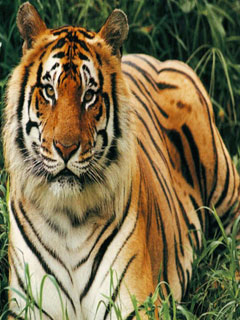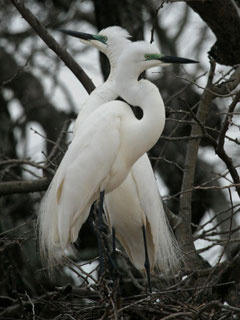Jungles king

The lion (Panthera leo) is one of four big cats in the genus Panthera, and a member of the family Felidae. With some males exceeding 250 kg (550 lb) in weight, it is the second-largest living cat after the tiger. Wild lions currently exist in Sub-Saharan Africa and in Asia with a critically endangered remnant population in northwest India, having disappeared from North Africa, the Middle East, and Western Asia in historic times. Until the late Pleistocene, which was about 10,000 years ago, the lion was the most widespread large land mammal after humans. They were found in most of Africa, much of Eurasia from western Europe to India, and in the Americas from the Yukon to Peru.
Lions live for around 10–14 years in the wild, while in captivity they can live over 20 years. In the wild, males seldom live longer than ten years as fights with rivals occasionally cause injuries. They typically inhabit savanna and grassland, although they may take to bush and forest. Lions are unusually social compared to other cats. A pride of lions consists of related females and offspring and a small number of adult males. Groups of female lions typically hunt together, preying mostly on large ungulates. The lion is an apex and keystone predator, although they will scavenge if the opportunity arises. While lions do not typically hunt humans selectively, some have been known to become man-eaters and seek human prey.
The lion is a vulnerable species, having seen a possibly irreversible population decline of 30 to 50 percent over the past two decades in its African range.Lion populations are untenable outside of designated reserves and national parks. Although the cause of the decline is not fully understood, habitat loss and conflicts with humans are currently the greatest causes of concern. Lions have been kept in menageries since Roman times and have been a key species sought for exhibition in zoos the world over since the late eighteenth century. Zoos are cooperating worldwide in breeding programs for the endangered Asiatic subspecies.
Lions live for around 10–14 years in the wild, while in captivity they can live over 20 years. In the wild, males seldom live longer than ten years as fights with rivals occasionally cause injuries. They typically inhabit savanna and grassland, although they may take to bush and forest. Lions are unusually social compared to other cats. A pride of lions consists of related females and offspring and a small number of adult males. Groups of female lions typically hunt together, preying mostly on large ungulates. The lion is an apex and keystone predator, although they will scavenge if the opportunity arises. While lions do not typically hunt humans selectively, some have been known to become man-eaters and seek human prey.
The lion is a vulnerable species, having seen a possibly irreversible population decline of 30 to 50 percent over the past two decades in its African range.Lion populations are untenable outside of designated reserves and national parks. Although the cause of the decline is not fully understood, habitat loss and conflicts with humans are currently the greatest causes of concern. Lions have been kept in menageries since Roman times and have been a key species sought for exhibition in zoos the world over since the late eighteenth century. Zoos are cooperating worldwide in breeding programs for the endangered Asiatic subspecies.
Birds

Birds are best observed free in nature rather than in cages. Hang a bird feeder just outside the window and show the child how to sit quietly so that the birds won't be afraid.
Binoculars give the child a feeling of participating in the birds' activities, and allow the child to watch birds from a distance. Having temporary tadpole guests, and watching cocoons hatch is a truly magical experience for the child. It provides the experience of seeing a creature close up without having to keep it permanently out of its natural setting.
Because wild animals are less accessible to the children than plants, we suggest first observing birds, insects, and other animals in nature, to arouse an interest and, after this experience, providing more animal models, pictures, and books about them—picture books, beginning reading books, and reference books.
Playing with animal models and blocks has always been a favorite open-ended-toy choice of children. Please be sure that your child's animal models are made of safe plastic instead of toxic plastic materials. We find that the ones made by European companies are safe for children at this age.
We focus on the child's natural love for and affinity with nature, and the tendency to want to touch, hold, and care for nature specimens such as rocks, shells, seeds, flowers and leaves, insects, kittens—all things living and nonliving.
Books can help the child explore animals outside their immediate surrounding and learn even more names.
Another gift from our children comes to that adult when we slow down, to follow the interests of the child, being in the moment, appreciating nature that is all around us, taking the time to see and feel and hear, to just be.
Binoculars give the child a feeling of participating in the birds' activities, and allow the child to watch birds from a distance. Having temporary tadpole guests, and watching cocoons hatch is a truly magical experience for the child. It provides the experience of seeing a creature close up without having to keep it permanently out of its natural setting.
Because wild animals are less accessible to the children than plants, we suggest first observing birds, insects, and other animals in nature, to arouse an interest and, after this experience, providing more animal models, pictures, and books about them—picture books, beginning reading books, and reference books.
Playing with animal models and blocks has always been a favorite open-ended-toy choice of children. Please be sure that your child's animal models are made of safe plastic instead of toxic plastic materials. We find that the ones made by European companies are safe for children at this age.
We focus on the child's natural love for and affinity with nature, and the tendency to want to touch, hold, and care for nature specimens such as rocks, shells, seeds, flowers and leaves, insects, kittens—all things living and nonliving.
Books can help the child explore animals outside their immediate surrounding and learn even more names.
Another gift from our children comes to that adult when we slow down, to follow the interests of the child, being in the moment, appreciating nature that is all around us, taking the time to see and feel and hear, to just be.
